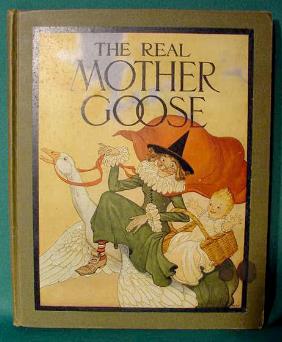

The second is that there still is controversy about how the Mother Goose tales originated. So, the first thing is that the person buried here isn't even the mother-in-law of Thomas Fleet (Do we know where Elizabeth Goose is buried?). So, somehow, partially from confusing the wives of Isaac, and partly for tourism sake, this grave was identified as being the grave of "Mother Goose." By 1833 only one of these books was left, and it was republished as The Only True Mother Goose. Fleet, after unsuccessfully trying to stop his mother-in-law from singing, compiled her songs and published them in 1719 as Songs for the Nursery or Mother Goose's Melodies for Children. Elizabeth, the older, grandmother to this child, used to sing songs that she had learned over time. She married Thomas Fleet, a printer and they had a son.

Isaac married Elizabeth Foster who had six children with him. So, the story goes that Isaac Goose married Mary Balston with him, and had 10 children with him. The grave stone is a sheet of slate with words imprinted - well worn. I used a guide handed to me at the entrance to find it. The grave is located toward the rear of the cemetery, to the right of the obelisk to the Franklin family. The Granary Burial Ground is located on the northwest side of Tremont Street, about a quarter mile northeast from Boston Common. "About this title" may belong to another edition of this title.In Boston, within the Granary Burial Ground, is this grave for Mary Goose, supposedly the first 'Mother Goose.' `The Westergard book is such a goofy delight!' (William Rueter) Then we're confronted, on the opposing page, with the same character depicted much later in a life that has typically not been kind, together with Jim's commentary on their plight. As he offers the rhymes, often with additional verses never heard before, the artist presents his portrait of the younger participant in the rhyme. Jim Westergard has selected some of the more violent, cruel and unusual nursery rhymes from Mother Goose and has imagined the characters as real people. The rhymes we knew as children were also read aloud to our great, great, great grandparents and, in their day, the stories were intended to prepare them for survival in a world much tougher than our own. Mother Goose laid some juicy goose eggs, sunnyside up, around the nursery. Now consider that some, or even most, of the characters in the Mother Goose nursery rhymes were modelled on real people and you've got the beginnings of Mother Goose Eggs, sunnyside up. A close look at Mother Goose's nursery rhymes reveals cruelty, violence and bizarre behaviour. Looking for a place to lay blame for all the violence and cruelty in the world today? Lay it at the feet of Mother Goose. Smyth sewn into 16-page signatures with hand-tipped endleaves front and back. 'On the one hand it's a joke book, and on the other it's a very serious collection of portraits.' ' - Quill & Quire Printed offset by Tim Inkster on the Heidelberg KORD at the printing office of the Porcupine's Quill in the Village of Erin, Wellington County, Ontario, Canada. 'He's looking at old age and the violence of life in a way that could be considered really sick, but there's also a real pathos to it,' says Jack Illingworth of the Porcupine's Quill. He illustrates each rhyme with a two-colour portrait and a larger, black-and-white depiction of the young protagonist as they might have aged - which is usually not very well. With tongue in cheek, Westergard plays up the cruel nature of many classic nursery rhymes - spousal abuse in 'Tom, Tom, of Islington', child neglect in 'Hush a by Baby', and religious oppression in 'Goosey, Goosey, Gander', for example. The book pairs 25 Mother Goose nursery rhymes (many of which include an unfamiliar and disturbing stanza or two) with Westergard's engravings. `Jim Westergard may not be the first to invest children's standards with modern sensibilities (think Jon Scieszka's The True Story of the 3 Little Pigs or James Finn Garner's Politically Correct Bedtime Stories), but he achieves a special blend of sarcasm and poignancy in Mother Goose Eggs, Sunnyside Up.


 0 kommentar(er)
0 kommentar(er)
